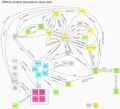New Readers/Industry analysis
-
Industry analysis of offline ecosystem
-
Value web describing exchanges in offline ecosystem
Industry analysis
editOffline Wikimedia content
editFully offline
editThere are a number of hardware, software, and content providers working on distributing Wikipedia content offline throughout the world. This deck (also embedded on this page) examines this industry from a few different perspectives for a fuller understanding.
It's possible that there are more offline offerings or distributors - please let us know if you're aware of any and we will add them.
Partially offline
edit- The Wikipedia Apps have a "save for later" feature that allows users to bookmark articles. Those articles are later available offline, but can't be shared.
- Downloading content.
- Wikibooks
- Screenshots
- Progressive web apps
- Prototypes
- RFC for an API driven frontend
- ServiceWorker Phabricator task to provide offline support and progressive loading
Other affordability work
editThere are many other NGOs, companies, and governments around the world working on providing affordable internet access. We'll collect information here about what else we learn about.
- The Indian state Kerala commits to providing free wifi to all of its citizens.
- We are gathering some of what we learn in a google spreadsheet. This is definitely WIP.
Other offline support
edit- Youtube India supports downloading videos for offline viewing, and on some networks can do this during off-peak hours.
- URL to PDF makes a PDF out of a website.
- send to apps/sites for reading offline (instapaper, pocket, etc)
- google drive is available offline
- mobile chrome (and maybe other browsers) offer print-->pdf
- Printing websites into books: http://theanarchistlibrary.org/library/emma-goldman-alexander-berkman-s-last-days
Offline sharing
edit- Sideloading
- Xender allows device-to-device transfering of files (pictures, videos, music, documents, apps). It works 1:1 or 1:many. Available for Android, iOS, and Windows phones.
- SHAREit (by Lenovo)
- ShareApp
- P2P

